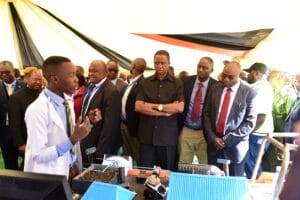CEC Innovation Hub at the Copperbelt Investment Expo
“Innovating the Future”
Why Innovation?
At CEC, we believe that there is a lot of new thinking and new ideas from every place in Zambia. What lacks are the platforms for people to share that thinking with the rest of the country and the world. CEC is all about innovation, our longevity is testament to that. It’s because we are continuously looking for and finding new ways of doing things that we have existed this long. We, therefore, desire to extend opportunities to others to equally innovate and even disrupt whole industries.
We believe that the future belongs to innovators. Here are the innovators that have brought fresh thinking, new and different ways of doing things:
BongoHive: based in Lusaka, BongoHive is innovation and technology hub that works with great minds, building viable solutions that change the world by providing a range of startup and tech programmes, workshops and events focused on making Zambia Africa’s next hotbed of innovation. BongoHive has created programmes crafted to gjuidestartups through their entrepreneurial journey – from the idea to getting investment. Established in 2011, BongoHive is Zambia’s first technology and innovation hub, founded to address the gaps the founders experienced working in the loca technology industry.
ZPOS: is a tech company, born in Lusaka, “with a dream bigger than life”. They have developed a point of sale system targeted at SMEs. The software allows small retailers to record sales, handle and track sales, manage their stock count, monitor and manage stock in real time, calculate their profit and loss and generate instant reports, and get daily sales, profit and stock reports and much more.
MPower Zambia: is made up of a young, diverse and motivated team with a passion for renewable energy. MPower finances and distributes affordable solar systems. They have partnered with Climate Management through which they sell solar products to civil servants on hire purchase. They are looking to partner with banks and other private sector organisations so they can finance the sale of products to non-civil servants on hire purchase terms. Currently, 90% of their clientele is made up of teachers in rural areas.
Safe Motherhood Alliance: founded in 2017, out of personal experience, Safe Motherhood Alliance (SMA) came up with a product to ensure women delivered safely. The award-winning SMA baby delivery kit is a low-cost disposable kit containing all requirements for safe and clean birth. The requirements are based on the protocol for safe and clean delivery prescribed by both the World Health Organisation and the Ministry of Health. All the items packed in the kit are sterile.
University of Zambia: (1) Internet of Things “(IoT) Telemetry Systems for Zambia Transport Command Center” is an automated communications process by which measurements are made and other data collected at remote inaccessible points and transmitted tot receiving equipment for monitoring, display and recording. Developed as an alternative to the conventional way of eliminating the risk factors for road traffic accidents, the IoT architecture that combines vehicle-to-on-ground station communication and vehicle-to-roadside sensor communication. Opposed to dedicated roadside units, which require major investments for purchase, installation and maintenance, roadside wireless sensor and networking technology represents a cost-effective solution and can leverage the deployment of the system as a whole because it utilizes the advantages of cloud computing and big data services internet of things offers.
(2) NETwork WATer BALance Locale (NetWatBalL): a web-based tool that enables easy management of utility data, monitoring and comparison of performance to help reduce the levels of Non-Revenue Water (NRW), which are high among utilities with water losses in some utilities being as high as 67 percent and a national weighted average of 51 percent. NetWatBalL is a tool for managing spatial data of networks and of customer connections and also allows for utility self-assessments. Using the supplied spatial data, plus consumption data, it calculates the amount of non-revenue water.
Copperbelt University: “IoT Mining Tracking and Safety Helmet” is a mining tracking system as a safety measure for the mining industry using a microcontroller-based circuit on the worker’s helmet. Using Radio Frequency (RF) based circuitry to detect workers moving through the entire mine mining site, the helmet is integrated with an RF based tracking system which in coordination with the RF tracker RF system help provide data over Internet of Things (IoT). The system uses an Atmega328P RF tracker circuitry to receive the data transmitted by worker helmet nodes. This helps map the location of mining workers in the mine site. Moreover, each worker’s helmet circuit is integrated with a panic/emergency button. This button when pressed shows an emergency sign on the IOT web platform about the worker emergency. This can be used for emergencies like-toxic gas inhalation, cave ins, physical injuries etc. Thus, the system ensures workers mining safety using IOT.
JETS: students from different schools around the Copperbelt are showcasing their projects with catchy models in what can be said is a primer for their upcoming regional championships. JETS has existed for many years to nurture budding talent in engineering, the sciences and technical learning.
The Innovation Hub is only one way through which CEC is inspiring the next generation to dream, create and inspire others too.


